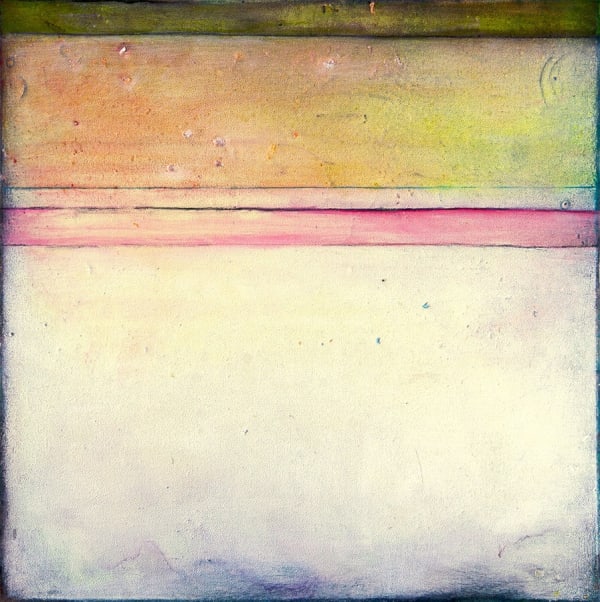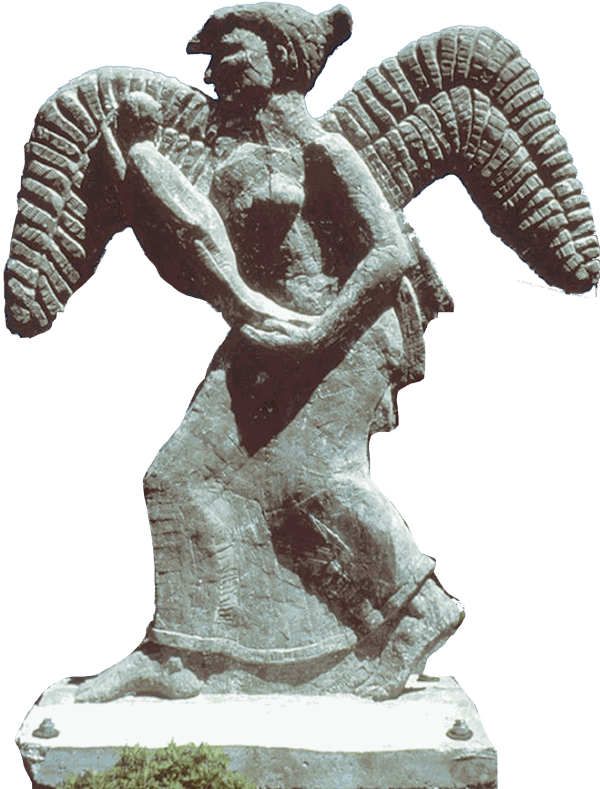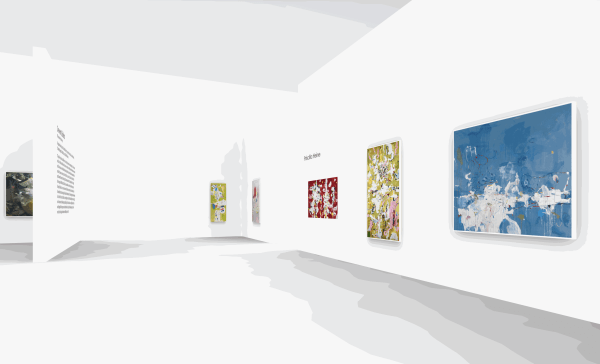"Despite obvious differences in style, medium and subject, the seven artists in this exhibition share a worldview. They are all mature women artists whose work has been shaped by our turbulent era and who maintain a reverence for art history, a dedication to craft and a profound sense of beauty. Three are abstract painters, two pay homage to folkloric traditions and two use their art to express a deeply felt eco-consciousness. Taken separately, each artist has formulated a strong individual statement. Taken together, their works ricochet off each other, creating a web of relationships surrounding such issues as the inseparability of abstraction and figuration, the melding of the personal and the social, and the importance of understanding nature and its processes..."--Eleanor Heartney
The title of this show points to these artists’ kinship. It also riffs off the backstory of the Pleiades, a constellation of stars who are also known as the Seven Sisters. Astronomically the Seven Sisters are described as a group of middle-aged, hot B-type stars in the north-west of the constellation Taurus. Mythologically, this constellation is said to represent the seven mountain-nymph daughters of the Titan Atlas, transformed into stars to protect them from the unwanted advances of the hunter Orion. Historically, the Seven Sisters were valued as navigational aids.
All these references provide suggestive metaphors for considering these works. The paintings of San Antonio based Kathy Sosa, for instance, reach across cultures to express a sense of female solidarity. She draws on the Mexican tradition of the Tree of Life as it appears in colorful intricate clay sculptures that combine floral, figurative and other motifs. Originally created to teach biblical stories to Native people, Tree of Life sculptures have now morphed into elaborate storytelling works that express all manner of personal and social concerns. In Sosa’s hands they become elaborate headdresses that serve as portraits of sorts and provide vehicles for the exploration of the dreams, hopes and fears of the woman whom they ornament.
Like Sosa, the sculptures of Deborah Masters draw on the powerful folkloric tradition that flourishes in the American Southwest. She blends this with her study of other figurative forms, including Chinese tomb figures, Etruscan art and Greek sculpture. Masters uses motifs and techniques from these traditions to explore such themes as democracy and immigration, animal spirits and cultural understandings of life and death. She works in clay, allowing evidence of the hand to remain on the surface of her figures, reminding us of their connection to the earth from which their materials originate. Her works here evoke Christian symbols that emphasize our ties to the animal world. Figures hold the dove, emblem of peace, hope and spirit, the fish, emblem of group identity and the lamb, emblem of innocence, purity and gentleness. Such symbols of faith and spirituality cross cultures and, like the Pleiades, guide us on our way
A sense of the vital importance of our connection to the non-human world plays out differently in the work of Christy Rupp. A committed environmentalist, she has long used her art to warn us about the crises precipitated by humanity’s callous treatment of nature. In her sculptures, birds, fish, mammals and micro-organisms are fashioned out of the plastics, commercial packaging, credit cards and bits of industrial debris that are contributing to their extinction. In her collages, several of which are included here, she juxtaposes scenes of nature and industrial development, wraps 19th century landscape paintings in the wild embrace of pipelines and oil tankers and combines naturalists’ drawings of biological specimens with nature-based patterns that have been stylized, tamed and made decorative for human consumption. These all provide vivid representations of the new geological era scientists have dubbed the Anthropocene in which human activity is now the primary driver of evolution and climate change.
Nancy Macko expresses a similar eco-consciousness in photographs from her Decomposition series. At first glance the images appear airy and abstract, full of shifting shapes and colors shot through with light in a way that is vaguely suggestive of old master paintings. But a closer look reveals that they are in fact composed of slowly dissolving bits of organic waste. One can make out a bit of onion skin here, a lemon peel or rotting cauliflower there. In fact these photographs capture the contents of Macko’s compost bin as kitchen waste is slowly transformed into valuable fertilizer. Here decay and decomposition are not signals of death but merely changes of state, leading to new life and new beauties. Composting involves the recognition that life and non-life are engaged in a continual process of exchange and transformation. Hence, Macko provides a hopeful vision of our interactions with nature, suggesting that a less human centric world would recognize and celebrate our mutual interdependence.
Virginia Bradley abstracts from nature in another way. The starting point for her luminous abstract paintings is her research into natural phenomena and geological and oceanographic formation. She describes painting as an alchemical process in which various painterly techniques and chemical reactions produce works that evoke air, water and atmospheric changes. By eliminating any sense of the hand, she creates paintings that feel like they have been painted by light and color. Composed of thin layers of oil paint poured directly on the canvas and enhanced with various mediums, these are works to be seen through as well as looked at. They draw on Bradley’s travels in India, Spain, England, Puerto Rico and throughout the United States and on her experiences of such phenomena as the geysers of Yellowstone Park and the ancient waters in the Soudan Iron Mine in Tower, Minnesota. Bradley now lives in the Berkshire mountains of Massachusetts; whose unique light and air infuse her current work.
Priscilla Heine also cites her natural surroundings as an important source for her abstract paintings. She has been particularly influenced by her time in the Northeast Kingdom of Vermont since 1979, her summers on the Mediterranean and her current life on the eastern end of Long Island in the northwest woods of East Hampton, New York from 1992-2020. In her vibrant, expressionistic paintings a sense of nature’s light and color meld with memories, autobiographical details and quotidian experiences to create works that often seem to hover on the edge of figuration. The compositions present an interplay of line and color, sometimes suggesting quirky creatures or bits of landscape adrift in dreamlike ether, sometimes evoking clouds of color billowing over grounds of riotous color. A recurring motif is the Calla lily, seen here in And then the Rain, which is for Heine an emblem of harmony and joy. Shapes, lines and colors shift and mutate throughout her paintings, bringing to life the sense of a world in a constant state of flux and movement.
Gail Winbury is also a connoisseur of chaos. Her paintings have an edgy quality that evokes complex emotions transcribed into paint. Shapes suggestive of bodies and body parts butt up against each other in almost-narratives and the clash of colors and shapes creates a tension between the figuration that lurks inside her abstraction and the almost visceral violence of the movement of line and color. She notes her love/hate relationship with the work of Willem de Kooning whose aggressively painted women are at once powerful and demeaning. Her gestural approach plays on such paradoxes – using paint to express the complicated mix of feelings that make us human.
Using art to make sense of a complex and every changing world, these seven artists are sisters indeed. Like the Pleiades, they are stars who share a constellation but each of whom burns brightly on her own.
--Eleanor Heartney
-
 Virginia Bradley, Catena 5, 2019
Virginia Bradley, Catena 5, 2019 -
 Virginia Bradley, St Croix 8, 2019
Virginia Bradley, St Croix 8, 2019 -

Virginia Bradley, St Croix 9, 2020
-

Virginia Bradley, Yellowstone 1, 2019
-
 Virginia Bradley, Yellowstone 14, 2020
Virginia Bradley, Yellowstone 14, 2020 -
 Virginia Bradley, Yellowstone 16, 2020
Virginia Bradley, Yellowstone 16, 2020 -
 Priscilla Heine, Attention, 2020
Priscilla Heine, Attention, 2020 -
 Priscilla Heine, Cactus, Moonlight, Dream , 2020
Priscilla Heine, Cactus, Moonlight, Dream , 2020
-
 Priscilla Heine, Cerulean, Pools, 2014
Priscilla Heine, Cerulean, Pools, 2014 -
 Priscilla Heine, Floating, 2018
Priscilla Heine, Floating, 2018 -
 Priscilla Heine, Monkey in the Middle, 2020
Priscilla Heine, Monkey in the Middle, 2020 -
 Priscilla Heine, Raft Painting, 2016
Priscilla Heine, Raft Painting, 2016
-

Nancy Macko, Garlic Sheaves, 2021
-

Nancy Macko, Cauli Oil, 2020
-

Nancy Macko, Untitled Decomposition (lemon), 2021
-

Nancy Macko, Decompositions: Untitled II, 2021
-

Nancy Macko, Odalisque, 2021
-
 Afgan Family Cross
Afgan Family Cross -

Deborah Masters, Mexican Madonna Cross, 2005
-

Deborah Masters, Circle Cross, 2013
-

Deborah Masters, Rebar and Madonna Cross, 2007
-

Deborah Masters, Cross with Afghanis, 2007
-

Deborah Masters, Cross of Saints and Lambs, 1997
-

Deborah Masters, Cross of Pakistan Earthquake, 2005
-

Deborah Masters, PA Field Cross, 2004
-

Deborah Masters, National Geographic Girl Cross, 2005
-

Deborah Masters, Tsunami Cross, 2006
-

Deborah Masters, Black Madonna Cross, 2006
-

Deborah Masters, Jesse, 2007
-

Deborah Masters, Luna Moth Crucifix, 2018
-

Deborah Masters, Angel in Flight
-

Christy Rupp, Toxic Molecules
-

Christy Rupp, Filter Feeding Organisms from the Gulf of Mexico, 2010
-

Christy Rupp, Snap Shots I 2020, 2020
-

Christy Rupp, Snap Shorts 2020, 2020
-
 Arbol Blanco No3 On My Mind Nopalitos Varios
Arbol Blanco No3 On My Mind Nopalitos Varios



















































